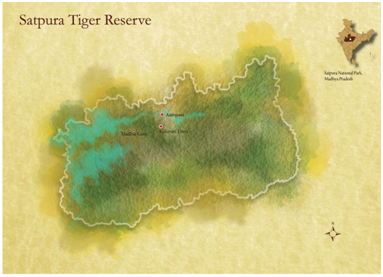eISSN: 2575-906X


Mini Review Volume 2 Issue 4
Biologist, Nandankanan Zoological Park, India
Correspondence: Rajesh Kumar Mohapatra, Nandankanan Zoological Park, Bhubaneswar, Odisha, India-754005
Received: June 18, 2018 | Published: July 13, 2018
Citation: Mohapatra RK. Rare observations of inter-specific interaction of sloth bear and leopard with Indian pangolin at Satpura Tiger Reserve, Central India. Biodiversity Int J. 2018;2(4):331-333. DOI: 10.15406/bij.2018.02.00082
The present note reports two incidences of behavioural interaction of sloth bear and leopard with Indian pangolin in wild along with photographic evidence at Satpura Tiger Reserve, Madhya Pradesh, India.
Keywords: sloth bear, satpura tiger reserve, Indian pangolin, ecology, habitat
Indian Pangolin (Manis crassicaudata) distributed throughout peninsular India, Sri Lanka, Bangladesh and Pakistan.1,2 Knowledge on ecology and inter-specific association of Indian pangolin is limited because of their nocturnal and secretive habit. The Sloth bear (Melursus ursinus) is widely distributed on the Indian subcontinent– India, Nepal, Bhutan, and Sri Lanka and Bangladesh–ranges from the base of the Himalayas to the southern tip of the Western Ghats including the island of Sri Lanka.3,4 Leopards are distributed in Asia and Africa.5 In India, they are found throughout the country except the arid parts of Kutch and Rajasthan and the high Himalayas.6 Due to their wide distribution range both sloth bears and leopards share their home range with each other and also with Indian pangolins. In this communication, we report two incidences of inter-specific interaction of sloth bear and leopard with Indian pangolin at Satpura Tiger Reserve, Madhya Pradesh, India.
The Satpura Tiger Reserve (22°19' to 22°30' N and 77°56' to 78°20' E) is a 1428 km2 protected area located in the Hoshangabad district of Madhya Pradesh (Figure 1). The observations taken were ad-libitum and serendipitous. The photographs were taken by the photographers (see acknowledgement) using digital cameras. The incidence was observed near [RKM1] Kaali Maati Dam area in Madhai Core Zone of Satpura Tiger Reserve at 16:49PM on 11/12/2017. The habitat was surrounded by thick vegetation included (i) moderately high grasses and (ii) tall trees including Tectona grandis, Chloroxylon swietenia, Aegle marmelous, Cassia fistula, Diospyros melanoxylon, Terminalia tomentosa, Madhuca latifolia and others. An adult male sloth bear was found exploring the ground and probing the nearby ground with his front hands at times. After a while the bear started digging near the termite mound. The bear found standing straight on his hind limbs ending the digging activity. In the fore limbs, the bear was tightly holding a sub adult Indian pangolin (Figure 2). The bear was vigorously shaking the partially curled up pangolin to open its coil. Though the bear was initially successful in partially opening up the caudal part of the pangolin, the pangolin recuperated its lost grip and tightly coiled around itself. Although the bear kept on trying but it didn’t get success in uncoiling the pangolin. After some time, when the bear became conscious about the presence of vehicle and human it swiftly turned back and vanished into the forest holding the pangolin tightly in its fore limbs.
In another incidence involving leopard and Indian pangolin was sighted in January 2016 at Aampani area of the sanctuary. While being photographed it moved into a thicket and was stalking for something which later revealed as a pangolin. The pangolin became coiled when the leopard charged on it (Figure 3). Then the leopard made many attempts to uncoil the pangolin using its fore limb paws for few minutes. The capability of holding its grip and presence of impregnable scales on outer body successfully shielded the pangolin from the claws of this wild predator. Ultimately the leopard became aware the presence of the vehicle and rushed into the forest. After a while (~15 minutes), the pangolin got uncoiled and moved into nearby thicket.

Figure 1 Satpura Tiger Reserve with observation sites (Marked in red); Leopard-Indian pangolin incidence at Kalamati Dam and Sloth bear- Indian pangolin incidence at Aampani.
Inter-specific interactions like the present observations are usually infrequent and rarely reported. There is a chance of inter specific competition between sloth bear and pangolin due to convergent feeding habits (both being myrmicophagous) and sharing common habitat and food resources. Indian pangolins feed primarily on ants and termites.1,7 The sloth bear has specialized on insect prey, particularly termites and ants.8‒10 About 72.7% of the sloth bear diet also includes termites.10 This inter-specific interaction is thought to be associated with overlapping home range and the pursuit of food sources, which may be explained by their appearance near termite mound. Similar interactions between pangolin and sloth bear could not be found from the available literature.
There are reports of predation of Indian pangolin by leopard in Sothern India.11 Similarly there were reports and photographic documentation of predation/ predation attempts on Indian pangolin by Asiatic lion (Panthera leo persica) in Gir National Park, India,12 by tiger (Panthera tigris) in Pench National Park, India,13 and by mugger crocodile (Crocodylus palustris) in Yala National Park, Sri Lanka (Figure 4; Charlotte Arthun, Photographer, United states; Personal communication). It is worth noting that, hunting of the pangolins by human beings possesses a major threat for decline of their population than that of other wild animals.14 Given their infrequent occurrence, continual study is recommended to gain further insight into extend and function of their inter-specific associations, habitat use and home range of these endangered Indian pangolins.
The author is thankful to the photographers, Ranjit Giri, Madhya Pradesh, India; Malay Mandal, Madhya Pradesh, India and Charlotte Arthun, San Francisco, United States for sharing the photographs of sloth bear-Indian pangolin incidence, leopard-Indian pangolin incidence and mugger crocodile-Indian pangolin incidence, respectively. The author also acknowledges the help extended by Malay Mandal in preparation of the map.
Authors declare that there is no conflict of interest.

©2018 Mohapatra. This is an open access article distributed under the terms of the, which permits unrestricted use, distribution, and build upon your work non-commercially.